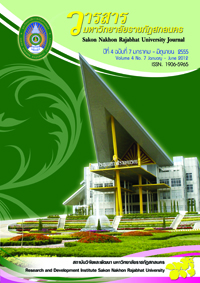คำศัพท์ภาษาอังกฤษในหนังสือแบบเรียนสำหรับผู้เรียนใน ระดับประถมศึกษาในประเทศไทย
Abstract
บทคัดย่อ
สำหรับการศึกษาขั้นพื้นฐานในประเทศไทย ภาษาอังกฤษได้ถูกกำหนดให้ใช้สอนเป็นภาษาต่างประเทศ โดยกระทรวงศึกษาธิการได้กำหนดเนื้อหาสาระและจำนวนคำศัพท์ที่ผู้เรียนจะได้เรียนรู้เมื่อจบการศึกษาในระดับ ประถมศึกษา ซึ่งผู้เรียนต้องเรียนภาษาอังกฤษในวงคำศัพท์ตามหัวเรื่องเกี่ยวกับตนเอง ครอบครัว โรงเรียน สิ่งแวดล้อม อาหาร เครื่องดื่ม เวลาว่างและนันทนาการ สุขภาพและสวัสดิการ การซื้อขาย และลมฟ้าอากาศ แต่ อย่างไรก็ตามหลักสูตรไม่ได้ระบุคำศัพท์และจำนวนคำที่เหมาะสมในแต่ละหัวเรื่อง ดังนั้นจึงเป็นอุปสรรคสำหรับ ผู้เรียนและครูผู้สอนในการเลือกคำ ศัพท์เพื่อใช้ในการเรียนการสอนให้สอดคล้องกับหลักสูตรของ กระทรวงศึกษาธิการ การศึกษาครั้งนี้จึงได้สำรวจหนังสือแบบเรียนภาษาอังกฤษที่ใช้กันอย่างแพร่หลายในระดับ ประถมศึกษาในประเทศไทย และเลือกหนังสือแบบเรียนที่นิยมใช้มากที่สุดจำนวน 3 ชุด เพื่อวิเคราะห์คำศัพท์ หลักที่ปรากฏร่วมในหนังสือแบบเรียนนำมาเปรียบเทียบกับคำศัพท์มาตรฐานสากล 2,000 คำหลัก (GSL) โดยใช้ โปรแกรมวิเคราะห์คำศัพท์ที่เรียกว่า Range Program และจัดคำศัพท์หลักที่ปรากฏร่วมในหนังสือแบบเรียนมาจัด เข้าหัวเรื่องตามเนื้อหาที่กระทรวงศึกษาธิการกำหนดไว้ จากการศึกษาพบว่าหนังสือแบบเรียนที่ถูกเลือกมีจำนวน คำศัพท์ที่เหมาะสมกับระดับประถมศึกษาเมื่อเปรียบเทียบกับคำศัพท์มาตรฐานสากล (GSL) และสามารถจัดเข้า หัวเรื่องตามเนื้อหาที่กระทรวงศึกษาธิการกำหนด อย่างไรก็ตามคำศัพท์มาตรฐานสากล 2,000 คำนี้มีความสำคัญ อย่างยิ่งสำหรับครูหรือผู้เกี่ยวข้องซึ่งควรตระหนักในการเลือกใช้คำศัพท์ที่เหมาะสมกับระดับชั้นเพื่อประโยชน์ที่จะ เกิดกับนักเรียน
Abstract
In Thai primary schools, the national curriculum under the Ministry of Education has offered English courses and provided outlines for contents and words taught across the nation. After graduation, learners had to gain vocabularies through the established themes, namely myself, my family, my school, the environment, foods, beverages, free time and recreation, health and welfare, selling and buying and the climate, and would be able to use one word sentences, phrases, simple sentences and compound sentences accurately. However, there is no detailed claim of exact words to be set in each theme as the curriculum states. In practice, this could lead to differences and difficulties for practitioners in terms of word choices and contents to be taught in classroom. Thus, the primary goal of this study was to compare the English headwords found in the English coursebooks which were widely used in Thai primary schools throughout the country. Another goal was to establish those words found in the English coursebooks into themes. In response to those goals, three series of English coursebooks widely used in Thai primary schools were purposively chosen for the study. The Range program was employed to compare and analyze the English headwords of the chosen coursebooks. The study revealed three series of the English coursebooks provided sufficient proportions of vocabulary essential for primary school students to build up their lexical knowledge, the most 2,000 high frequency words in particular. In effect, the classification of the words found in the study could be established in 10 different themes as per the Ministry of Education. In conclusion, GSL words were sizable proportions of useful for teachers with a well-prepared instruction and provided an adequate portion for learners in the classroom.









